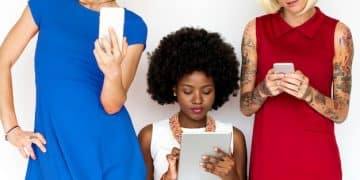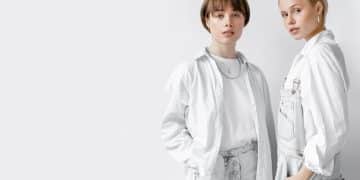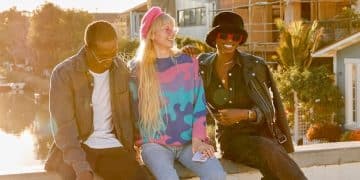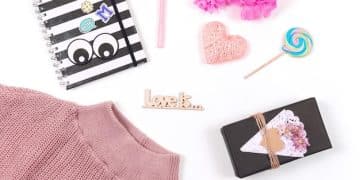TikTok and Instagram: Shaping Fashion Trends in the US
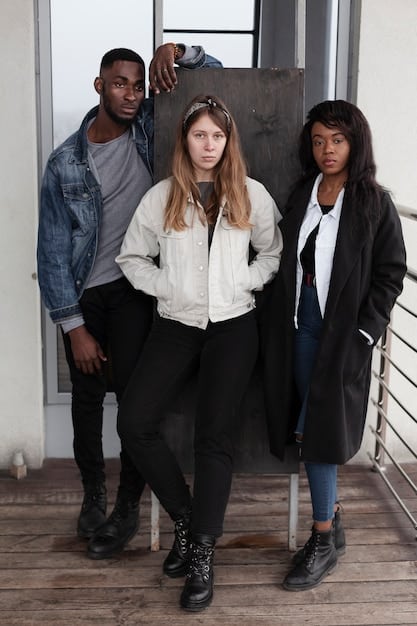
TikTok and Instagram have revolutionized the US fashion landscape, influencing trends, consumer behavior, and the overall fashion industry through viral challenges, influencer collaborations, and direct-to-consumer marketing.
The lines between the runway and the digital screen have blurred, thanks to the pervasive influence of social media. Platforms like TikTok and Instagram are no longer just for sharing snapshots; they’re shaping fashion trends in the US, dictating what’s hot and what’s not. Let’s dive into how these platforms are revolutionizing the fashion industry.
The Rise of Social Media as a Fashion Authority
Social media has evolved from a simple communication tool to a dominant force in shaping cultural trends, including fashion. Platforms such as TikTok and Instagram have democratized access to fashion, allowing anyone to become a trendsetter and influence consumer behavior.
The Power of Visual Platforms
Platforms like Instagram and TikTok are visually driven, making them ideal for showcasing fashion trends. The ability to share photos and videos instantly has created a culture of constant visibility and a desire to stay on top of the latest styles.
Democratization of Fashion
Social media has broken down traditional barriers in the fashion industry. No longer is fashion dictated solely by designers and magazines; now, anyone can share their style and influence others. This democratization has led to a more diverse and inclusive fashion landscape.

Here are some key aspects of how social media platforms have become fashion authorities:
- Instant Trend Adoption: Trends spread rapidly through social media, allowing consumers to adopt them quickly.
- Influencer Marketing: Influencers collaborate with brands to promote products and styles, driving sales and shaping perceptions.
- User-Generated Content: Everyday users share their outfits and styles, creating a constant stream of inspiration for others.
In conclusion, social media’s visual nature and democratization of fashion have reshaped how trends are born and adopted, making platforms like TikTok and Instagram key players in the US fashion industry.
TikTok’s Influence on Fast Fashion Trends
TikTok has emerged as a major trend incubator, particularly for fast fashion. The platform’s short-form video format and algorithm-driven content dissemination have created a unique environment where trends can go viral overnight.
The Viral Nature of TikTok Trends
TikTok’s algorithm favors engaging content, leading to the rapid spread of trends. Fashion challenges, outfit reveals, and styling tips can quickly gain millions of views, driving consumers to seek out the featured items.
Impact on Consumer Behavior
The platform’s influence isn’t just limited to awareness; it directly impacts consumer behavior. Products featured in viral videos often experience a surge in demand, leading to sell-outs and a scramble to find similar items.
TikTok’s influence can be seen in several areas:
- Micro-Trends: These short-lived trends gain popularity quickly and fade away just as fast.
- Duets and Challenges: Users participate in fashion-related challenges and create duet videos, amplifying the trend’s reach.
- Affordable Fashion: TikTok often showcases affordable fashion options, making trends accessible to a wider audience.
Ultimately, TikTok’s viral nature and focus on affordable fashion have made it a powerful force in shaping fast fashion trends and consumer behavior in the US.
Instagram’s Role in High-End Fashion Promotion
While TikTok dominates fast fashion, Instagram has become an essential platform for promoting high-end fashion. Its visually appealing interface and emphasis on curated content make it an ideal space for luxury brands, designers, and fashion influencers.
Visual Storytelling and Branding
Instagram’s focus on high-quality images and videos allows brands to tell compelling visual stories. This is particularly important for high-end fashion, where image and aesthetics are crucial to brand identity.
Influencer Collaborations with Luxury Brands
Luxury brands leverage influencer marketing on Instagram to reach a wider audience. By partnering with fashion influencers who embody their brand values, they can create aspirational content that drives engagement and sales.
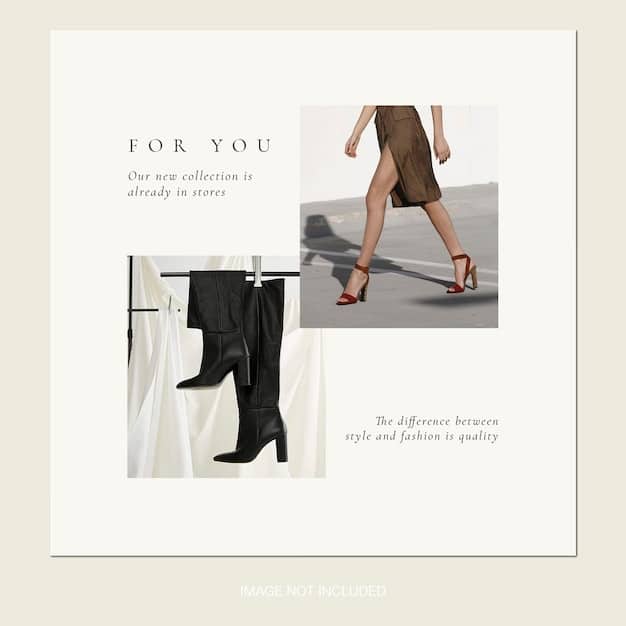
Instagram’s influence can be seen in several ways:
- Runway Shows: Live streams and behind-the-scenes content from runway shows are shared on Instagram, giving followers exclusive access.
- Product Placement: Luxury brands strategically place products in influencer content to increase visibility and drive purchases.
- Engaging Content: Brands create interactive content, such as quizzes and polls, to engage with their audience and gather feedback.
Essentially, Instagram’s visual storytelling capabilities and influencer collaborations have made it a vital platform for high-end fashion brands to promote their products and connect with consumers in the US.
The Blurring Lines: When High Fashion Meets TikTok
The distinction between high fashion and TikTok trends is becoming increasingly blurred as luxury brands recognize the platform’s potential for reaching younger audiences and driving brand awareness. This has led to innovative collaborations and marketing strategies that blend the exclusivity of high fashion with the accessibility of TikTok.
Luxury Brands Embracing TikTok
Many luxury brands are now actively engaging with TikTok’s audience through creative campaigns, influencer partnerships, and user-generated content initiatives. These efforts aim to make high fashion more relatable and engaging for younger consumers.
Successful Brand Campaigns on TikTok
Several luxury brands have launched successful TikTok campaigns that have generated significant buzz and increased brand visibility. These campaigns often involve challenges, duets, and creative content that align with the platform’s playful and interactive nature.
Consider these examples:
- Brand Takeovers: Luxury brands have utilized TikTok’s brand takeover feature to display full-screen ads and promote specific products.
- Hashtag Challenges: Brands create challenges and encourage users to participate, generating user-generated content and increasing brand exposure.
- Influencer Content: Luxury brands partner with TikTok influencers to create content that showcases their products in a relatable and engaging way.
In summary, luxury brands are strategically leveraging TikTok’s reach and engagement to break down barriers and connect with a younger demographic, redefining the boundaries between high fashion and social media trends.
The Impact on US Retail: From Online to In-Store
The influence of social media on fashion transcends the digital world, significantly impacting retail in the US. From online shopping experiences to in-store strategies, social media trends are reshaping how consumers discover, engage with, and purchase fashion items.
Driving Online Sales
Social media acts as a powerful catalyst for online sales, with platforms like TikTok and Instagram serving as discovery engines for new products and brands. Shoppable posts, influencer marketing, and user-generated content all contribute to driving online traffic and conversions.
Transforming the In-Store Experience
Retailers are adapting their in-store strategies to align with social media trends, creating visually appealing displays, interactive installations, and personalized shopping experiences that cater to social media-savvy consumers. The goal is to create “Instagrammable” moments that encourage shoppers to share their experiences and promote the store on social media.
Key aspects of this transformation include:
- Visual Merchandising: Stores are designing displays and layouts that are visually appealing and photogenic, encouraging shoppers to take photos and share them on social media.
- Interactive Installations: Retailers are incorporating interactive elements, such as selfie stations and augmented reality experiences, to engage shoppers and create memorable moments.
- Personalized Shopping: Stores are using data and analytics to personalize the shopping experience, tailoring product recommendations and promotions to individual customer preferences.
All in all, social media’s influence is profoundly impacting both online and in-store retail experiences, driving innovation and shaping the future of fashion commerce in the US.
Criticisms and Concerns: Fast Fashion and Sustainability
While social media has revolutionized the fashion industry, it has also amplified concerns surrounding fast fashion and its impact on sustainability. The rapid pace of trend cycles and the pressure to constantly consume can lead to overconsumption, waste, and ethical issues.
The Environmental Impact of Fast Fashion
Fast fashion’s emphasis on affordability and disposability has significant environmental consequences, including textile waste, water pollution, and carbon emissions. Social media amplifies these issues by promoting a constant stream of new trends, encouraging consumers to buy more and discard items more quickly.
Ethical Considerations in the Fashion Industry
The fast fashion industry is often criticized for its labor practices, which can include low wages, unsafe working conditions, and exploitation of garment workers. Social media plays a role in raising awareness of these issues, with activists and influencers using platforms to call for greater transparency and accountability.
Sustainable efforts in the fashion industry include:
- Eco-Friendly Materials: Brands are increasingly using sustainable materials, such as organic cotton, recycled polyester, and plant-based alternatives.
- Ethical Production: Companies are implementing fair labor practices and ensuring safe working conditions in their factories.
- Circular Economy: Brands are exploring circular economy models, such as clothing rental, resale, and recycling programs, to reduce waste and extend the lifespan of garments.
In closing, while social media has fueled the growth of fast fashion, it has also provided a platform for raising awareness and promoting sustainable alternatives, encouraging consumers to make more conscious choices and support brands committed to ethical and environmental responsibility.
| Key Point | Brief Description |
|---|---|
| 📱Social Media Authority | TikTok and Instagram are major fashion trend setters. |
| ⚡TikTok’s Impact | Drives fast fashion through viral trends and challenges. |
| 📸 Instagram’s Promotion | Promotes high-end fashion through visual storytelling. |
| 🛍️ Retail Transformation | Social media reshapes online and in-store retail experiences. |
FAQ
▼
TikTok and Instagram influence fashion trends through viral challenges, influencer collaborations, and visual content. Users showcase their styles, brands promote products, and trends spread rapidly across both platforms.
▼
Fast fashion refers to rapidly produced, inexpensive clothing. TikTok contributes by promoting hyper-trends and encouraging frequent purchases, driving demand for these items.
▼
Luxury brands use Instagram for visual storytelling, partnering with influencers, and showcasing runway shows. High-quality images and videos emphasize brand identity and aesthetic appeal.
▼
Ethical concerns include the environmental impact of fast fashion, labor practices, and waste generation. Social media helps raise awareness, promoting sustainable choices and responsible brands.
▼
Consumers can choose eco-friendly materials, support ethical brands, reduce consumption, and participate in clothing rental or resale programs. Social media also provides tips and resources for sustainable fashion.
Conclusion
In conclusion, the impact of social media: how TikTok and Instagram are shaping US fashion trends has been profound. While these platforms have democratized fashion and accelerated trend cycles, leading to both innovation and concerns about sustainability, they undeniably remain a vital force in the industry.
